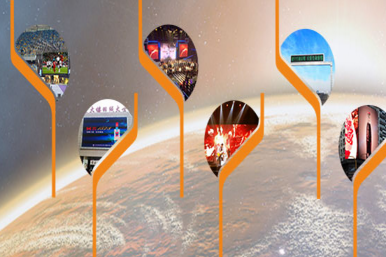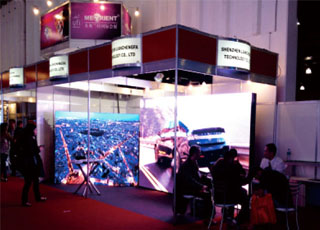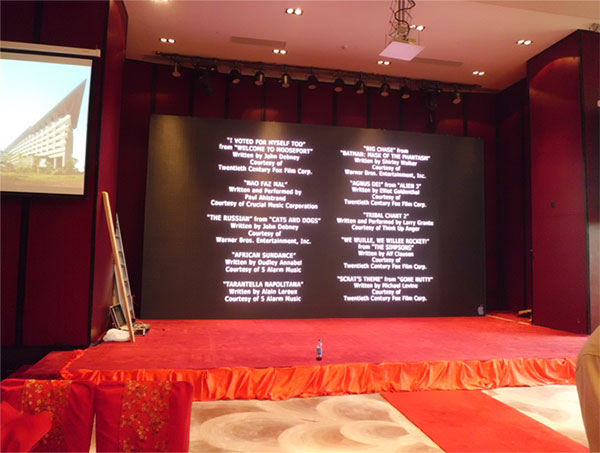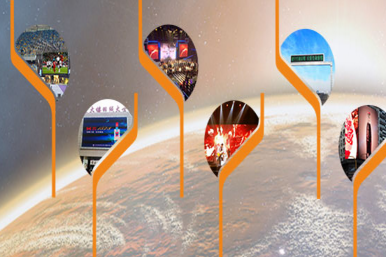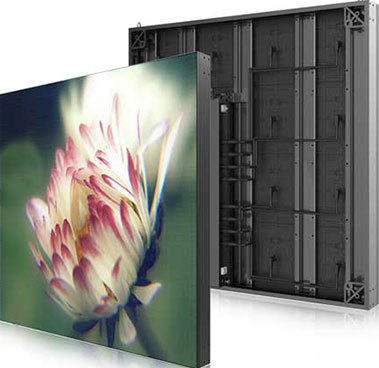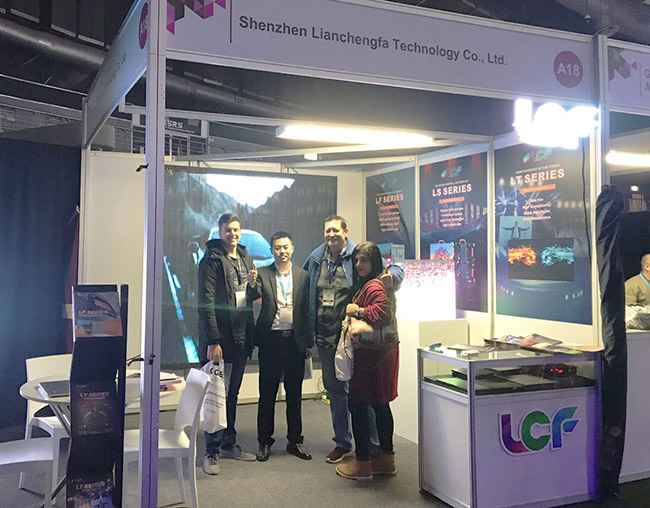Publisher: Supplier of LED Display Time: 2022-03-09 17:26 Views: 1729
In the past two years, several domestic LED manufacturers have successively obtained the DCI certification in the film industry, which proves that the domestic LED display film projection system fully meets the DCI giant screen film projection specification in terms of technology and performance. However, according to industry analysts, it will take some time for domestic LED movie screens to rise in the market in terms of market supply and technology.
The global film projection market is not "open" to free competition
Many LED brands and enterprises in my country have passed the DCI certification in which "content suppliers" dominated by Hollywood's seven major film companies have taken the initiative. Combined with the previous DCI certifications of Samsung and LG products, it is basically enough to show that the LED large-screen movie projection system , in terms of hard indicators such as technology and performance, it fully meets DCI's so-called high-quality and copyright protection needs.
However, from the perspective of the global film projection market, Samsung LED screen, as the first "brand" to obtain DCI certification, has been operating in the industry for three or four years and has gained only a handful of market shares. Basically an "experimental" application. As another Korean company LG, its LED products have gained a limited share of the screen market for the time being.
On the other hand, traditional European and American DLP projectors and Japan's Sony LCOS projectors, as iconic products in the digital projection era, still occupy the vast majority of the market share in the movie screen industry. Even some industry experts believe that the development of LED movie screens in the past three or four years has not even achieved "a fraction of the increment of the global movie screen market". That is to say, the real market of LED movie screen is "it is only technically recognized, not the application side really starts to spread out".
This can be seen from the fact that the DCI certification of my country's local LED screen companies is concentrated in the last 10 months. The essence of DCI certification is that the film content industry has set a threshold for the "screening circle": a technical threshold to ensure display effects and copyright protection. It is not an industry mandatory standard, nor is it a national standard or an international standard, but it is a factual entry threshold for "if you do not meet this standard, you cannot release blockbusters from Hollywood bigwigs".
In other words, from a legal point of view, the DCI standard is more like a means for a few powerful content providers to cut the "equipment market cake". This is one of the reasons why American DLP technology digital cinema projectors "absolutely dominate" the global market. ——The American projection technology and American content production constitute a chain of common "interests" under the ties of capital.
This also explains the "difficult problems" of the DCI certification of the two large LED screens: 1. Why was the Korean brand the first to obtain the DCI certification of the large LED screen? The LED large screen industry chain of Samsung and LG needs to adopt a large number of products and technologies from the domestic LED industry. Because Korean companies, including Samsung and LG, have closer capital ties with Europe and the United States. 2. Under the background of traditional movie projection equipment companies such as Sony and NEC in Europe, America and Japan, which are also active global brands of LED large-screen displays, even leading brands, why did these companies not launch large-screen LED movie screens for the first time? What about the product? Because, as the vested interests of the existing semi-monopoly structure of the industry, they are more willing to consolidate the old advantages than to embrace new technologies.
Content, core technology, standards and capital camps, there is such a global 'distributed' cake system in the movie projection equipment market! Industry insiders pointed out that even if the local LED movie screen has obtained the DCI certification, it is not easy to enter this interest system. Compared with technological breakthroughs, the landing of the market consumer side will be "more difficult".
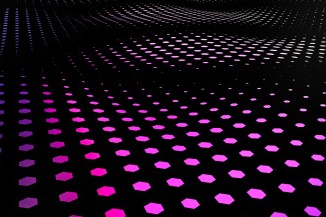
If the local LED movie screen wants to rise, it must prove that it is not only "good", but also "better"
Why can domestic LED large screens achieve the achievement of many brands obtaining DCI certification in a short period of time? Industry experts analyzed that this is of course because the local LED display industry chain is already in a leading position in the world, and the large LED display screen can effectively meet the needs of movie screenings, and it is also a manifestation of the role of "market leadership".
That is to say, the domestic film market has continuously become the largest independent screening market at the global box office, and it is also the world's largest in terms of the total number of cinema screens and the annual increment. This is enough to attract the attention of the global film industry, including content and equipment manufacturers. As the DCI standard is an "industry alliance" standard, if there are too many inappropriate obstacles to my country's LED large-screen enterprises, it is obviously not in line with the long-term interests of the international film industry chain entering the Chinese market on a larger scale.
At the same time, as the de facto standard of the global movie projection market, DCI has indeed seen the "potential advantages" that the LED movie large screen system may have: mainly, first, in terms of brightness performance, the LED large screen and the projection projection system are completely different. different. The image quality bottleneck of the projection system, especially the image quality bottleneck of 3D projection, is insufficient brightness. The advantage of the large LED screen is that the brightness is sufficient, and it needs to be specially designed in the "low brightness, dark room" mode during the movie projection.
Second, in recent years, the audio-visual industry chain has developed towards ultra-high definition, and the 8K standard will become one of the pursuits of the film industry sooner or later. In this regard, the LED large screen system realizes the 8K of the movie screen, and even higher resolution without pressure; on the contrary, the traditional projection system in the 8K era will inevitably face the technical challenges and cost changes brought by the larger light valve system. .
Of course, as a brand-new projection technology, the LED large-screen system also has its own "disadvantages": the first is the solution to the problem of pixel granulation. This requires large LED screens to encrypt pixel density to a certain extent and provide better on-pixel lenses and packaging designs. The second is the projection stability of the LED large screen system. The traditional LED outdoor large screen, often appearing "caterpillar" vision, partial damage, etc., is a fatal defect for the film projection effect. Entering the screen projection market, LED large screens need better stability and reliability.
Therefore, it can be seen that in terms of technical characteristics, the LED large screen is "completely different" from the traditional projection film projection equipment. This will inevitably lead to the decision of the film industry that "eggs cannot be put in one basket". In other words, the technical advantages of the LED movie large screen system are also one of the reasons why the DCI certification system is "willing to issue certification". The indoor small-pitch LED large-screen system, which has continuously overcome pixel granularity and has proven its reliability in high-end command and dispatch centers, shows higher potential for future technological development - at least the current evidence shows this conclusion.
The above market logic also proposes a standard direction for the large-scale implementation of LED large-screen systems in the film screen industry: that is, DCI certification is just the beginning, and the LED large-screen film projection system must not only prove that it can, If it can be done, it is no worse than the projection projection system; at the same time, it is necessary to prove that it has unique advantages - what others have and what I have, can we truly cut our own cake from the semi-monopoly film projection technology market.
Easy to use and economical", LED movie screens need to make good use of the advantages of the domestic market
In my country's film projection market, the current core technologies mainly come from two major projection systems, DLP and LCOS. Core devices are highly dependent on external sources. Therefore, the voice of establishing a film projection equipment industry based on local advanced technology has been issued from time to time.
In fact, in the early "film" film era, my country once established a complete industrial chain of independent projection systems. In the era of digital movies, the projection equipment market has been handed over to people, and it is only a matter of nearly seventeen or eighteen years. This historical fact also shows that the domestic demand scale of my country's film projection market is sufficient to support the establishment of an independent projection technology system.
In particular, based on the LED large-screen display technology, my country has established an independent film projection equipment system, which has unique advantages: 1. my country is in the global leading position in the LED industry chain and technology; The ability to make up for system performance defects; 3. The technology of LED movie large screen has a much higher "commonality" with the technology of most indoor conferences, command and dispatch centers, and advertising large screens than movie projection projectors and ordinary business education and home projection. The "commonality" of the machine. This determines that, using the huge traditional industry chain of LED large screen, LED movie large screen may gain the dual competitiveness of "performance advantage and cost advantage" in the future.
The above industrial advantages, combined with the scale and rapid development advantages of my country's film industry, can be said that the large LED film screen "has both the right place and the right place in the domestic market". This is also the reason why domestic companies are still enthusiastic about the LED movie projection market under the background of weak penetration of LED screens in the global cinema screen market. At present, about 200,000 to 300,000 square meters of new movie theaters are added every year in China, which will be a huge incremental market space for the LED large-screen industry and a cornerstone market for it to grow.
To sum up, the marketization of LED movie projection screens is just the first step. Taking full advantage of the advantages of the LED industry chain, the performance advantages of large LED screens and the demand advantages of the domestic cinema chain market, the local LED film large screen industry is expected to become the global leader in the "next-generation film and projection system".
